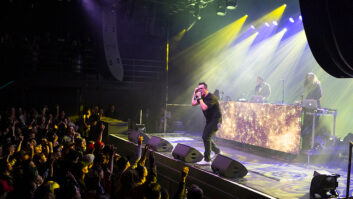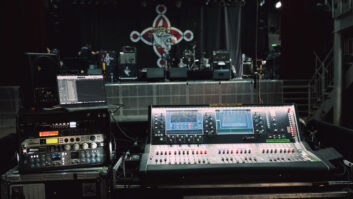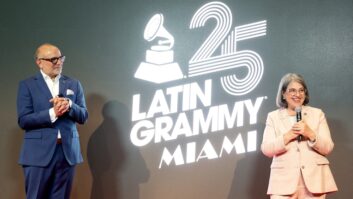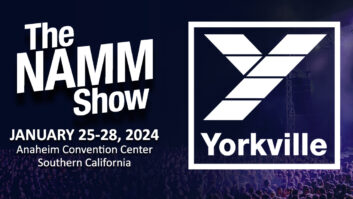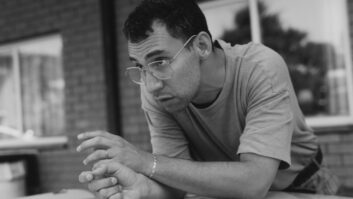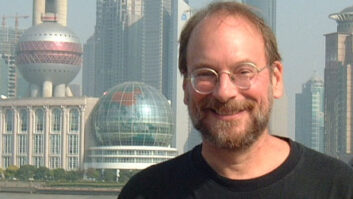Woody Guthrie left behind such a large body of unpublished lyrics that Billy Bragg and Wilco could probably spend the rest of their careers writing and recording music for them. That was the problem when British punk/folk singer/songwriter Bragg took a look at the 40 songs charted on a big piece of paper on the wall of Totally Wired Studio in Dublin, Ireland, in January 1998.
Surrounded by moody musicians enduring six weeks of perpetual rain in a chilly warehouse studio, Bragg could see the writing on the wall: There were obviously too many good tracks to fit on one disc. A double-CD was out of the question for Wilco, who had just released the critically acclaimed but financially punishing Being There. And so Mermaid Avenue and its recently released follow-up, Mermaid Avenue, Volume 2 (both on Elektra) were born.
“I remember saying, ‘Geez, we’re going to have to stop,'” Bragg recalls during a phone interview from his London home. “So when we were actually figuring out which tracks would go on Mermaid Avenue, I think all of us felt in our hearts that there would be a volume two because the songs that we recorded were all so strong. So it was okay to leave a song as powerful as ‘Hot Rod Hotel,’ ‘All You Fascists,’ or ‘Blood of the Lamb.’ It’s not as if they’re the second best.”
Nothing in modern musical history quite compares to the Mermaid Avenue project, but then few figures in American musical history compare to Guthrie. on both Mermaid Avenue albums, Bragg and Wilco took on a task that would probably intimidate most musicians: Set a long-gone legend’s 40- to 50-year-old lyrics to music. “I wanted to work with people that knew they didn’t know Woody Guthrie. And I include myself in that group of people as well,” Woody Guthrie’s youngest daughter Nora Guthrie says with an earthy laugh. She began to delve into the boxes of her father’s little known writing when she started the Archives eight years ago. “I mean, I knew my dad, but I didn’t know his writing. And I felt very comfortable working with Billy and Wilco: They knew something but not too much; it wasn’t part of their generation, and I knew that as artists they would be free. You know, that they would just make the best damn music they could.”
The thousands of lyrics, accompanied by no notated or recorded music, at the Woody Guthrie Archive on 57th Street in New York City are a testament to a particularly prolific period in the songwriter’s life, speculates Wilco’s guitarist/keyboardist/songwriter/engineer Jay Bennett, who sifted through lyrics at the Archive with Wilco lead vocalist/songwriter/guitarist Jeff Tweedy. “The Joe Klein book [Woody Guthrie: A Life; 1980] has one of Woody’s lists, and one of the top things on his list was ‘write a song every day.’ His list was ‘drink less,’ ‘smoke less,’ ‘womanize less’ and ‘write a song every day,'” the Chicago resident drawls. “I don’t know if there’s any other artist with that many lyrics that the music was lost for. There’s probably close to 10 years of Woody’s life where he couldn’t set words to music, physically, during the last few years of his life. [Guthrie suffered from Huntington’s disease and died in 1967 at 55.] So, you have all this material from a career that really wasn’t focused on recording.”
The first Mermaid Avenue album introduced folk and country old-timers and No Depression country, rock and alternative newcomers to a new kind of Woody Guthrie: less the icon that wrote “This Land Is Your Land” and more the man who wrote eloquently about lust, loss, politics, pop culture and spirituality.
That was a major consideration in structuring the first album, says Bragg. “The picture we’re trying to paint is of a contemporary Woody Guthrie. So therefore it’s important that you have a song on there like ‘Ingrid Bergman,’ which draws him away from being a political icon and more into a flesh-and-blood character who’s having fantasies about a film star of his day. I had a very clear idea of the Woody Guthrie that I wanted to portray, as opposed to the classic Woody Guthrie that you Americans have in some ways constructed over the past 40 years since his death, first by Bob Dylan and then by people who came after,” he says.
Mermaid Avenue was universally acclaimed by critics, nominated for a Grammy and, Bragg says, sold more than all of his own records combined. on Volume 2, Guthrie’s lyrics go uptown and urban, tackling recognizably modern subjects with impassioned or whimsical twists on “Airline to Heaven,” “My Flying Saucer,” “Hot Rod Hotel” and “Joe DiMaggio Done It Again.” The 1942 “All Your Fascists” rages against race hatred in blunt, sing-along verses and ragged guitars. The stunning, literary lyrics of songs such as “Remember the Mountain Bed” are given simple musical settings so that they might shine. Lyrically bare-bones tunes like “Someday Some Morning Sometime” provide an open canvas for Wilco’s sonic experiments with, say, tape delays.
The journey to Mermaid Avenue began at a 1992 concert celebrating Guthrie’s 80th birthday in Central Park in New York City. Bragg played the Guthrie song he knew best, “Pretty Boy Floyd” and met Nora Guthrie. A couple years later, she wrote to Bragg and outlined her idea. She wanted to find some musicians to write music for the lyrics at the Woody Guthrie Archive, which she and Woody Guthrie’s manager Harold Leventhal direct. “Very, very cleverly, she actually sent me in that letter some photocopies of some of the lyrics, which, when I realized how powerful and vivid these lyrics were, how complete they were, I was very interested to go and see her in the Archives,” Bragg says.
Digging through the papers at the one-room archive, Bragg found lyrics he was interested in. Nora Guthrie would fax those she found intriguing, and four years ago, the singer/songwriter began demoing tunes at a friend’s house. Part of the deal was that Bragg would be able to choose the musicians he worked with. Nora Guthrie could choose the title-which is named after the street the Guthrie family lived on in Brooklyn and the address stamped on many of the lyrics-and even the songs. But Bragg had specific ideas about the sound. “Trust me with the musicians,” he recalls saying to her, “because I want to pitch this in a way that people just don’t dismiss it as a Billy Bragg record-too political-or a country or folk music record-too acoustic.”
In 1997, Bragg enlisted Wilco as his house band, and eventually fellow songwriters, because, he deadpans, “I felt it would be wrong for me as an Englishman to keep all this for myself. I thought that was a bit unfair, being a foreigner and all.”
But seriously, he explains: “Nora’s initial suggestion was that there would be a number of different singers for every track, and she had a list of folk artists who would all love to contribute. But I was afraid it would sound like a…tribute album. Tribute albums are a fine idea, but very often, they’re about the artists that perform rather than the songs that are being recorded. So I thought that it would good if there was just like a house band that played all the songs so there was a continuity of feel, and so when I thought about what band that might be, Wilco really were my prime objective. All those Americana bands suddenly turned up, but none of them for my money could play in the various styles that Wilco obviously could on Being There. I knew Jeff Tweedy from when he was in Uncle Tupelo, and I knew that if I could explain this project to him, he would get it.”
As for Bragg, it was easy to come up with music for such well-crafted lyrics: “The songs are so sturdily constructed in their imagery but also in their internal rhythm, that you could play them all sorts of speeds, all sorts of ways. The lyrics shine, really. It was an absolute pleasure, for me as a musician, to do these songs, and as a songwriter, it’s even greater, because I didn’t have to put my soul into the lyrics that I write myself. These lyrics were already there, and they had soul-they had Woody’s soul. All I had to do was to put them, if you like, in a frame. We were finding beautiful portraits and making nice frames for them, so they could be displayed.”
Eventually Bragg invited Wilco to go to the archives and pick out lyrics for themselves. “It occurred to me that I was choosing songs that reflected my own point of view,” Bragg observes. “Then it became very, very important for me to get some other songwriters involved, to get them into the Archive to choose their own songs-that it wasn’t just my version of Woody Guthrie that was coming out. I never would have chosen ‘California Stars,’ for instance, off the last album, and that has been one of the standout tracks from that album. But it didn’t ring a bell with me, whereas it rang a bell with Jeff and Jay.”
Bragg and Wilco together recorded demos of several songs at King Size Sound Laboratories in Chicago in the fall of 1997 with engineers Dave Trumfio and Mike Hagler. Some lead and backing vocals were recorded by guest artists Corey Harris and Natalie Merchant at Fort Apache in Boston. Recording moved in the winter of ’98 to Totally Wired in Dublin, where Wilco, Bragg and Bragg’s longtime producer Grant Showbiz produced. Jerry Boys, fresh from Buena Vista Social Club, engineered.
Working as they would as Wilco, Tweedy and Bennett first learned the songs on acoustic guitars and then looked for appropriate other instruments, which ranged from a resonator guitar (which Bragg had never played previously) to an electric sitar owned by Bennett. Separate iso booths were built around drummer Ken Coomer, Bragg and Tweedy. “Actually, one of the reasons there might be any sonic continuity to this record at all is the fact that Totally Wired is actually a very similar room to our studio [The Loft in Chicago],” says Bennett. “We attempted to get some isolation on the vocals and acoustic guitars, but you’re only halfway successful doing that in a big room. There’s always drums coming through the piano mic and drums coming through the acoustic and vocal mic. We just set up in a little circle, and we actually used very little of the giant room. We just kind of moved our little semi-circle from one part of the room to the next to vary the sound.” Vocal mics were Shure SM7 and SM57s
At Totally Wired they recorded to 24-track analog at 15 ips “to get a little more stuff on a single reel and give it a little bit of a lo-fi, warm sound,” says Bennett. Bragg would record one of his songs, then Tweedy and Bennett would record one of their own, sometimes playing the same song in three or four different styles before settling on one. In the group’s song-a-day approach, they’d start with basic tracks and end with a rough mix, recording everything live with as few overdubs as possible, since as Bragg says, the songs were fresh and deserved “to be captured in that moment of creation.”
Mixing happened around the corner at Windmill Lane in Dublin, and this process proved to be somewhat combustible. “I’ve never made an album where someone else had a veto on mixes, nor had Jeff Tweedy,” says Bragg. “His ideas and my ideas weren’t the same, but we managed to find a compromise. We had to go back and say, ‘Look, you mix your tracks and I’ll mix my tracks, and you can comment on mine, and I’ll comment on yours, but in the end, I’ll accept that you’ll be happy with your tracks and I’ll be happy with my tracks. And if there’s any dispute, Nora will come in and make the decision.’ She had the final say-much against her will, I must say; she didn’t want the grief! She wanted everyone to be friends.”
But as Bragg notes, they cared enough about the project to overcome any personal difficulties that arose, and eventually, they put together Volume 2. Bragg went back in the studio to redo a vocal or two, which he called a “bit flat. Shh, don’t tell anyone,” he cackles. And this spring, Tweedy and Bennett returned to The Loft, their 4,900-square-foot, cement storage facility-turned-rehearsal room-turned-project studio, to record nine more tracks, four of which made it onto Volume 2.
“We built some gobos and used some of our anvil cases and stuff to build walls and put up some curtains but it’s essentially still a giant cement room, and you can only get away from it sounding like a giant cement room so much,” says Bennett. “We actually kind of like the sound of the room, and, in fact, on the tracks that we recorded there, we never used any reverb because we got all we needed from the space itself. What’s good is that it makes you not put a lot of mics on things, because if you put 11 mics on a drum kit, that’s just 11 more mics picking up the sound of the room. It makes us take real minimalist approaches, recording the drum kit with three mics.” They often relied on the Shure KSM32 and Bennett’s favorite “all-purpose mic of all time,” the AKG 414. “It just records the entire frequency spectrum relatively flat, damn near any instrument in any context with it.”
For these sessions, Amek loaned Wilco a 56-channel Recall RN console and they recorded to ADAT, which gave them the “insane amount of flexibility” they needed to burn as much tape as they wanted and to experiment. “The thing about ADATs is that if you’re unsure about what you’re doing, or if you’re spontaneous or experimental in your approach to music like we are, you might want to roll tape for an hour and not have to decide which take is the best until a week later,” he says. “I think you have to be careful with ADATs: You have to use them in conjunction with other gear. Sometimes you want things to come back at you a little bit saturated or a little bit duller or a little bit thumpier or warmer.”
Neve preamps, a UREI compressor, old ribbon mics, and other outboard gear lent by their friend, engineer Jonathan Pines of Private Studios in Urbana, Illinois, helped warm up the sound. “I’ve also got a whole collection of old Altec tube preamps that I use a lot,” says Bennett. “The Altec stuff is about the only old stuff that’s affordable anymore. The 1567A sums several tube mic pre’s to one master output so you can put a couple mics on a guitar amp and then combine them to one output. That gives you tube warmth, and on something like ‘Airline to Heaven’ we used one to get some distortion on the vocal. We had a bunch of that gear for our basic tracking sessions and then we set up one or two really good signal paths, and we did a lot of our overdubs on our own with my little Mackie board.”
Some of those recent tracks, such as the airy, ambient “Someday Some Morning Sometime” are strikingly different from the Dublin tracks. “We really worked to get a kind of weird, airy track where you can’t really define what the instruments are. They all kind of blend together into one-this kind of atmospheric thing,” says Bennett, who engineered that song as well as “Airline to Heaven.”
On “Someday,” Bennett got to use the Delayaphone, an instrument Wilco invented, for an offbeat, echoey effect. It consists of a little set of vibes sent through a Roland Space Echo, which has a sound-on-sound tape loop feature that keeps going around and recording everything on top of what’s already there. “It’s a good way of adding an unpredictable atmosphere to a song, because you don’t know when what you recorded will come back around. We goofed around with the delay, and then I played it, miked it up, and Jeff messed with the knobs on the delay and he did all this tape distortion in delay and we did a couple of tracks of that,” explains Bennett.
Other offbeat instrumentation included Bennett’s two-tiered Farfisa keyboard, used in part for its weird percussion effects, Mellotrons, a saw and a Helpinstill Roadmaster piano, which was converted to a tack piano for two songs. “I’d put tacks on the hammers, and we’d use a combination of the direct pickup sound and then we’d mike it,” Bennett says. “There’s a bit of delay between the pickup and the mic, and that combination of delay and the sound of the tacks hitting the strings gives it an almost harpsichord-like quality.”
The most recent recordings were mixed by Pines and Wilco at Private Studios. Greg Calbi pulled Volume 2 together further during the mastering at Sterling Sound in New York City. Bragg and Wilco plan to tour together this summer, and Wilco is currently working on their next album at The Loft. Bragg also plans to record his next album this summer, perhaps playing with a band in the studio in a Mermaid Avenue style. And as a result of Mermaid Avenue, Nora Guthrie says her father’s work will also be getting more attention in a few more projects: ‘Til We outnumber ‘Em, a compilation of Woody Guthrie covers performed by Bragg, Ani DiFranco, Bruce Springsteen, the Indigo Girls, Dave Pirner, Ramblin’ Jack Elliott and Arlo Guthrie on DiFranco’s Righteous Babe label. A Rob Wasserman project highlighting Woody Guthrie’s prose will also be released on Atlantic in a few years.
But as the first ones to tackle the daunting task of putting a legend’s words to music, Mermaid Avenue’s players are in a somewhat privileged position to perhaps get to know Guthrie a little better than many others. Bragg notes, “The one time I did still feel very, very close to him was when we recorded a song that was on the first album called ‘Another Man’s Done Gone.’ There’s a line in that that says, ‘I don’t know I may go down or up or anywhere, but I feel like this scribbling will stay.’ And when we recorded that song, right at the end of the session-I wrote the music, Jeff sang it, Jay Bennett played it on the piano, and Nora Guthrie was in the room; she’d brought the lyrics that morning from America to Dublin-I felt like we were at least saying back to Woody, ‘Yeah. This scribbling will stay. These words are immortal.'”

